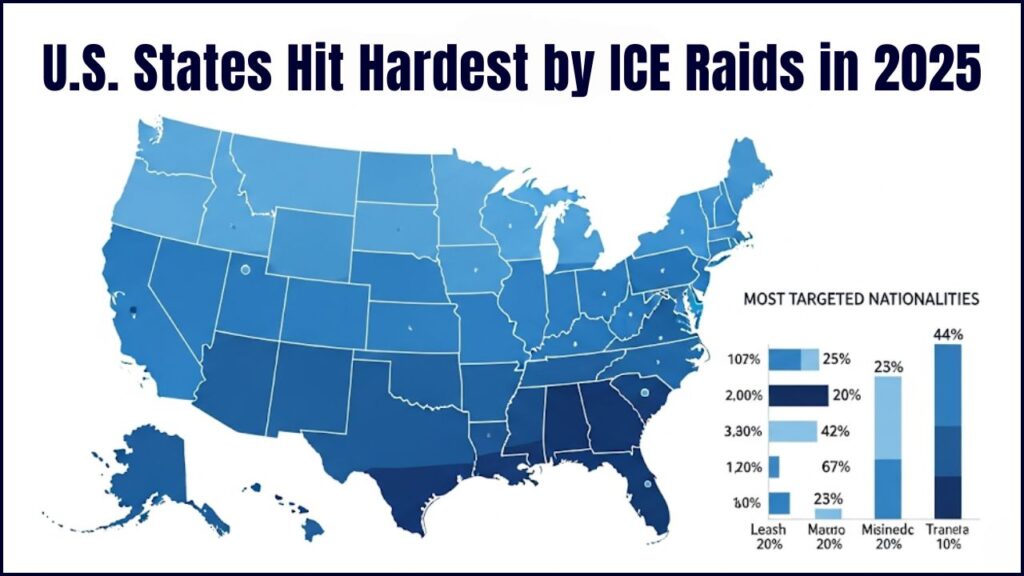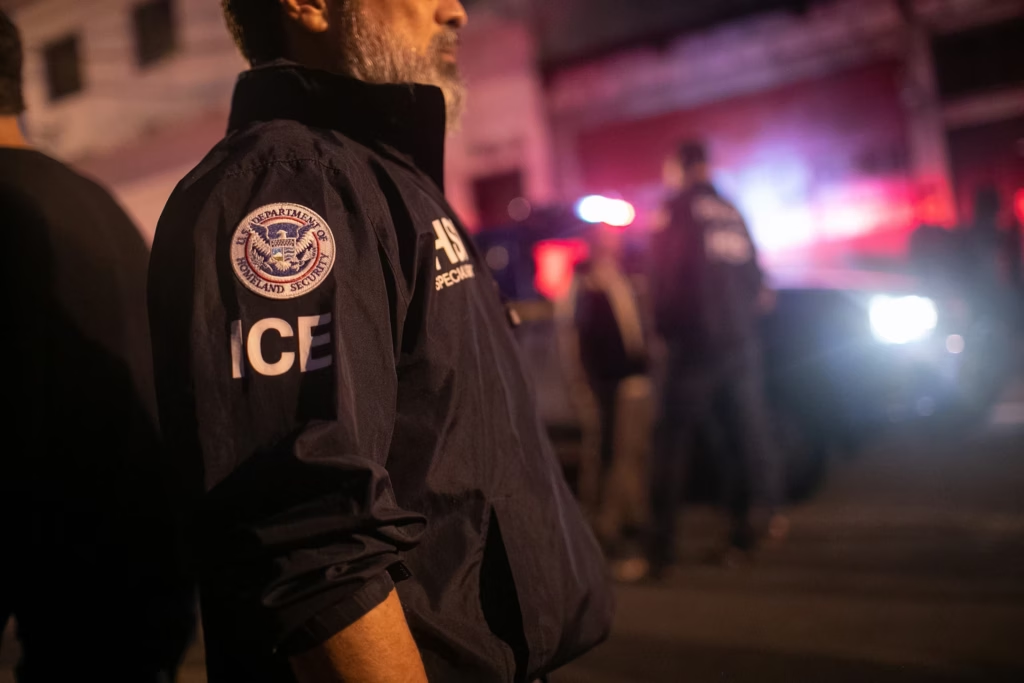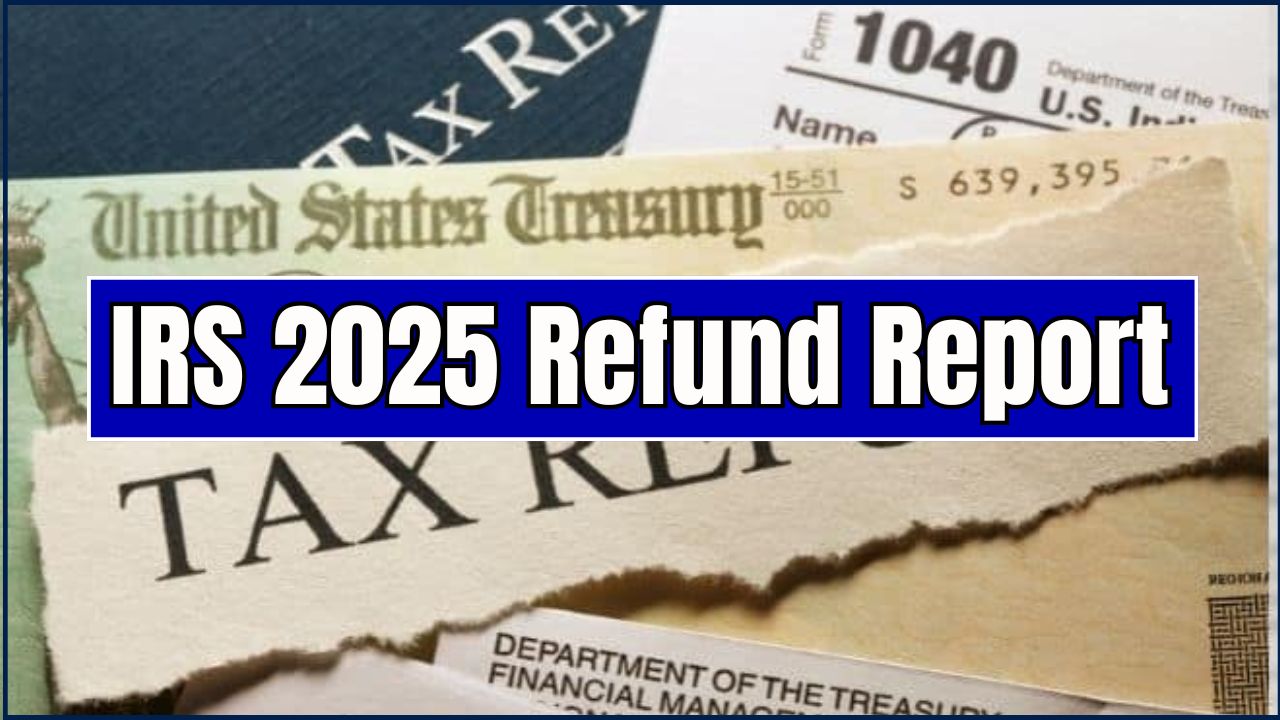If you’ve been hearing folks whisper over coffee about ICE raids heating up in 2025, you’re not imagining things. From the cornfields of Nebraska to the busy streets of Los Angeles, immigration enforcement has been hitting hard — and for many communities, it’s felt like a cold wind blowing right through their neighborhoods.

As someone who’s been around the block a few times, seen federal crackdowns come and go, and heard stories from tribal leaders, farmhands, and small business owners alike, I’m here to break it all down. We’ll look at which U.S. states got hit hardest, who was most targeted, and what this means for everyday folks — whether you’re running a farm, leading a church, or just trying to keep your family together.
U.S. States Hit Hardest by ICE Raids in 2025
| Key Data | Details |
|---|---|
| Top States Affected | Texas (13,087 detainees), Louisiana (7,379), California (3,471), Georgia (2,900), Arizona (2,594) |
| Largest Single Raid | Omaha, Nebraska – ~100 meat plant workers detained |
| Industries Hit Hardest | Agriculture, meat processing, hospitality |
| % with No Criminal Conviction | 71% of detainees had no convictions |
| Notable Targeted Groups | Latino/Hispanic, Puerto Ricans (U.S. citizens), Native Americans |
ICE raids in 2025 have reshaped conversations about immigration, community safety, and economic stability. Whether in border states or deep in the heartland, families and industries alike are feeling the effects. Knowing your rights, building local support networks, and staying informed are the best defenses against uncertainty.
A Little Historical Context
Immigration and Customs Enforcement (ICE) has been around since 2003, but the scope and style of raids have shifted over time. The 2025 surge mirrors patterns from the late 2000s when workplace raids were common — but with one key difference: the targets now are often far from the U.S.-Mexico border. This means small towns in Nebraska and racetracks in Louisiana are seeing the same kind of action that used to be limited to border cities like El Paso or Nogales.

The States Feeling the Heat
Texas — The Epicenter of Enforcement
Everything’s bigger in Texas — including ICE’s presence. By mid-2025, Texas led the nation with over 13,000 detainees. Local sheriffs in certain counties openly cooperated with ICE, increasing street arrests and workplace sweeps. This wasn’t just in border towns — we’re talking Dallas warehouses, Houston restaurants, and San Antonio construction sites.
Example: A small roofing crew in Austin reported losing half its team in a single week due to surprise worksite checks.
Louisiana — Raids Where You’d Least Expect
When you think Louisiana, you might picture Mardi Gras beads and Cajun cooking. But in Calcasieu Parish, a raid at Delta Downs Racetrack, Hotel and Casino ended with over 80 arrests — many of them stable hands and maintenance workers. The hospitality sector, usually a quieter target, has been feeling the squeeze.
California — Fields, Factories, and Fear
California saw over 3,400 detentions in 2025, especially in Ventura County and Oxnard. Raids often happened in the middle of harvest season, leaving berry farms and food processors scrambling to fill jobs. Community protests have been common — with local leaders urging “Keep families together” rallies.
Nebraska — The Heartland Hit
One of the largest single raids of 2025 happened in Omaha at a meat-processing plant. About 100 workers — nearly half the shift — were detained. This shook the local economy, showing that rural America isn’t immune.
Georgia & Arizona — Not Just Border States
Georgia’s poultry industry and Arizona’s farming sector both reported thousands detained. Many had been in the U.S. for over a decade, raising kids who are U.S. citizens.
Who’s Being Targeted — And Why It Matters
Latino/Hispanic Communities
Most detainees in 2025 were Latino or Hispanic. Advocacy groups claim racial profiling was widespread, with officers detaining people who “looked foreign,” even if they were citizens or had legal status.
Puerto Ricans — Citizens Caught in the Net
Puerto Ricans are U.S. citizens by birth, but that didn’t stop ICE from mistakenly detaining several. One case in Newark involved a Puerto Rican veteran arrested in a workplace raid — only released after proving citizenship.
Native Americans
Tribal members, including Navajo citizens, reported being detained despite presenting tribal IDs or Certificates of Degree of Indian Blood. This raises sovereignty questions and has sparked conversations between tribal governments and federal agencies.
Economic Ripples and Cultural Impact
These raids don’t just affect individuals — they hit local economies hard. In Nebraska, meat plants slowed production, causing supply chain hiccups and price jumps. In California, strawberry growers left acres unharvested because there weren’t enough hands in the fields.
Cultural events have also taken a hit. In several small towns, Latino heritage festivals were canceled due to fear of raids, cutting into tourism and community spirit. Native American powwows in border regions saw smaller attendance when out-of-state guests worried about checkpoints.
The Numbers Behind the Raids
According to TRAC Reports:
- 71% of ICE detainees in 2025 had no criminal convictions.
- Detainee numbers surged in states far from the U.S.–Mexico border, showing a nationwide strategy shift.
- Workplace raids, once rare, are now back in force.
2024 vs. 2025 ICE Arrests
| Category | 2024 (Jan–June) | 2025 (Jan–June) | Difference |
| Total Arrests | ~49,000 | ~109,000 | +122% |
| Top States | Texas, California, Arizona | Texas, Florida, California | Texas’s share increased significantly |
| Focus | Border security and individuals with criminal records | Border security, plus widespread arrests of non-criminal individuals | Major shift to interior enforcement |
Practical Advice for Communities and Employers
- Know Your Rights
- Individuals: You have the right to remain silent and the right to speak to a lawyer before answering questions.
- Employers: ICE must have a valid warrant to search non-public areas. Learn more at the ACLU Know Your Rights page.
- Have Documentation Ready
Keep copies of IDs, tribal cards, or passports handy. - Build Community Networks
Churches, neighborhood groups, and local councils can organize rapid-response teams. - Audit Workplace Compliance
Even if you believe all your workers are authorized, keep I-9 forms updated.
Top 3 Myths About ICE Raids
- Myth #1: ICE can only raid homes or workplaces with a warrant signed by a judge. Fact: While a judicial warrant is needed for a legal entry, ICE can sometimes gain access with an administrative warrant, or if they are given permission by the resident. It’s crucial to know the difference.
- Myth #2: People with no criminal record are not a priority for ICE. Fact: In 2025, there has been a significant increase in arrests of individuals with no criminal convictions, indicating a broadening of enforcement priorities.
- Myth #3: Everyone arrested by ICE is immediately deported. Fact: The deportation process can be lengthy. Many people arrested are placed in detention and have the right to a court hearing, though the process and outcomes can vary widely.
Real Stories from the Ground
- Maria, Farm Worker in Oxnard: “I’ve worked here 12 years, my kids are in school. One morning, ICE showed up and by the afternoon, four of my neighbors were gone.”
- Chief Thomas Gray, Tribal Leader in Arizona: “When our own citizens are detained because agents don’t recognize tribal IDs, that’s not just a mistake — it’s a violation of sovereignty.”
Frequently Asked Questions
Q: Can ICE detain U.S. citizens?
A: They shouldn’t, but in 2025, there were multiple cases of citizens — including Puerto Ricans and Native Americans — being wrongly detained.
Q: Are ICE raids only near the border?
A: No. In 2025, states like Nebraska, Georgia, and Louisiana saw major operations.
Q: What industries are targeted most?
A: Agriculture, meat processing, and hospitality.
Q: How can I track ICE activity in my area?
A: Follow local advocacy groups on social media, check community alerts, and stay connected to local immigrant coalitions.









